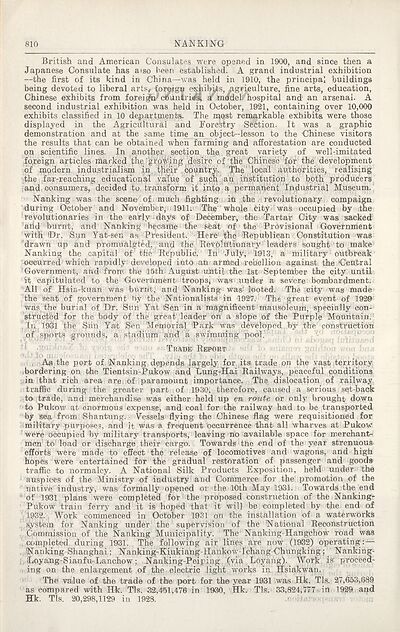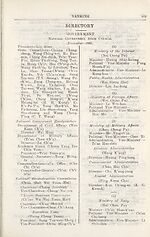1933
(894) Page 810
Download files
Complete book:
Individual page:
Thumbnail gallery: Grid view | List view

810
NANKING
British and American Consulates were opened in 1900, and since then a
Japanese Consulate has a iso been established. A grand industrial exhibition
—the first of its kind in China—was held in 1910, the principal buildings
being devoted to liberal arts, foreign eshibnts, agriculture, fine arts, education,
Chinese exhibits from foreign/cminlri^l af im^ielf hospital and1 an arsenal. A
second industrial exhibition was held in October, 1921, containing over 10,000
exhibits classified in 10 departments. The most remarkable exhibits were those
displayed in the Agricultural and Forestry Section. It was a graphic
demonstration and at the same time an object-lesson to the Chinese visitors
the results that can be obtained when farming and afforestation are conducted
on scientific lines. In another section the great variety of well-imitated
fo.reign articles marked the grpyfing desire of the Chinese for the development
of modern industrialism in their country. The local authorities, realising
the far-reaching educational value of such an institution to both producers
and consumers, decided to transform it into a permanent Industrial Museum.
Nanking was the scene of much fighting in the revolutionary compaign
during October and November, 1911. The whole city was occupied by the
revolutionaries in the early days of December, the Tartar City was sacked
arid burnt, and Nanking became the seat of the Provisional Government
with ©r. Sun Yat-sen as President. Here the Republican Constitution was
'drawn up and promualgted, and the BevbKttionary leaders sought to make
Nanking the capita] of the Republic. In July, 1913, a military outbreak
occurred which rapidly developed into an armed rebellion against the Central
'Government, and from, the 15th August until the 1st September the city until
it capiitulated to the Government troops* was under a severe bombardment.
Aik of Hsia-kuan was burnt, and Nanking was' looted. The city wag made
the seat of government by the Nationalists in 1927. The great event of 1920
was the burial of Dr. Sup Yat iSen in a magnifieent mausoleum, specially con¬
structed for the body of the great leader on a slope of the Purple Mountain.
Ir. 1931 the Sun Yat Sen Memorial Park was developed by the construction
of.spprti? grounds, a stadium and a swimming pool.'
Trade Report
As the port of Nanking depends largely for its trade on the vast territory
bordering on the Tientsin-Pukow and Lung-Hai Railways, peaceful conditions
in that rich area are. of paramount importance. The dislocation of railway
traffic during the greater part of 1930, therefore, caused a serious set-back
to trade, and merchandise was either held up en route or only brought down
to Pukow at enormous expense, and coal for the railway had to be transported
by sea from Shantung. Vessels flying the Chinese flag were requisitioned for
military purposes, and it was a frequent occurrence that all wharves at Pukow
were occupied by military transports, leaving no available space for merchant¬
men to load or discharge their cargo. Towards trie end of the year strenuous
efforts were made to effect the release of locomotives and wagons, and high
hopes were entertained for the gradual restoration of passenger and goods
traffic to normalcy. A National Silk Products Exposition, held under the
auspices of the Ministry of industry and Commerce for the promoftion of the
native industry, was formally opened or the 10th May 1931. Towards the end
of 1931 plans were completed for the proposed construction of the Nanking-
Pukow train ferry and it is hoped that it will be completed by the end of
1932. Work commenced in October 1031 on the installation of a waterworks
system for Nanking under the supervision of the National Reconstruction
Commission of the Nanking Municipality. The Nanking-Hangchow road was
completed during 1031. The following air lines are now (1932) operating: —
. .Nanking-Shanghai; Nanking-Kiukiang-Hankow-I'chang-Chungking; Nanking-
iLoyang-Sianfu-Lanchow; Nanking-Peiping (via Loyang). Work is proceed¬
ing on the enlargement of the electric light works in Hsiakwan.
The! value of the trade of the port for the year 1931 was Hk. Tls. 27,653,689
as compared with Hk. Tls. 32,451,476 in 1930, Hk. Tls. 33,824,777 - in 1929 and
Hk. Tls. 20,298,1129 in 1928. . . ,
NANKING
British and American Consulates were opened in 1900, and since then a
Japanese Consulate has a iso been established. A grand industrial exhibition
—the first of its kind in China—was held in 1910, the principal buildings
being devoted to liberal arts, foreign eshibnts, agriculture, fine arts, education,
Chinese exhibits from foreign/cminlri^l af im^ielf hospital and1 an arsenal. A
second industrial exhibition was held in October, 1921, containing over 10,000
exhibits classified in 10 departments. The most remarkable exhibits were those
displayed in the Agricultural and Forestry Section. It was a graphic
demonstration and at the same time an object-lesson to the Chinese visitors
the results that can be obtained when farming and afforestation are conducted
on scientific lines. In another section the great variety of well-imitated
fo.reign articles marked the grpyfing desire of the Chinese for the development
of modern industrialism in their country. The local authorities, realising
the far-reaching educational value of such an institution to both producers
and consumers, decided to transform it into a permanent Industrial Museum.
Nanking was the scene of much fighting in the revolutionary compaign
during October and November, 1911. The whole city was occupied by the
revolutionaries in the early days of December, the Tartar City was sacked
arid burnt, and Nanking became the seat of the Provisional Government
with ©r. Sun Yat-sen as President. Here the Republican Constitution was
'drawn up and promualgted, and the BevbKttionary leaders sought to make
Nanking the capita] of the Republic. In July, 1913, a military outbreak
occurred which rapidly developed into an armed rebellion against the Central
'Government, and from, the 15th August until the 1st September the city until
it capiitulated to the Government troops* was under a severe bombardment.
Aik of Hsia-kuan was burnt, and Nanking was' looted. The city wag made
the seat of government by the Nationalists in 1927. The great event of 1920
was the burial of Dr. Sup Yat iSen in a magnifieent mausoleum, specially con¬
structed for the body of the great leader on a slope of the Purple Mountain.
Ir. 1931 the Sun Yat Sen Memorial Park was developed by the construction
of.spprti? grounds, a stadium and a swimming pool.'
Trade Report
As the port of Nanking depends largely for its trade on the vast territory
bordering on the Tientsin-Pukow and Lung-Hai Railways, peaceful conditions
in that rich area are. of paramount importance. The dislocation of railway
traffic during the greater part of 1930, therefore, caused a serious set-back
to trade, and merchandise was either held up en route or only brought down
to Pukow at enormous expense, and coal for the railway had to be transported
by sea from Shantung. Vessels flying the Chinese flag were requisitioned for
military purposes, and it was a frequent occurrence that all wharves at Pukow
were occupied by military transports, leaving no available space for merchant¬
men to load or discharge their cargo. Towards trie end of the year strenuous
efforts were made to effect the release of locomotives and wagons, and high
hopes were entertained for the gradual restoration of passenger and goods
traffic to normalcy. A National Silk Products Exposition, held under the
auspices of the Ministry of industry and Commerce for the promoftion of the
native industry, was formally opened or the 10th May 1931. Towards the end
of 1931 plans were completed for the proposed construction of the Nanking-
Pukow train ferry and it is hoped that it will be completed by the end of
1932. Work commenced in October 1031 on the installation of a waterworks
system for Nanking under the supervision of the National Reconstruction
Commission of the Nanking Municipality. The Nanking-Hangchow road was
completed during 1031. The following air lines are now (1932) operating: —
. .Nanking-Shanghai; Nanking-Kiukiang-Hankow-I'chang-Chungking; Nanking-
iLoyang-Sianfu-Lanchow; Nanking-Peiping (via Loyang). Work is proceed¬
ing on the enlargement of the electric light works in Hsiakwan.
The! value of the trade of the port for the year 1931 was Hk. Tls. 27,653,689
as compared with Hk. Tls. 32,451,476 in 1930, Hk. Tls. 33,824,777 - in 1929 and
Hk. Tls. 20,298,1129 in 1928. . . ,
Set display mode to:
![]() Universal Viewer |
Universal Viewer | ![]() Mirador |
Large image | Transcription
Mirador |
Large image | Transcription
Images and transcriptions on this page, including medium image downloads, may be used under the Creative Commons Attribution 4.0 International Licence unless otherwise stated. ![]()
| Asian directories and chronicles > 1933 > (894) Page 810 |
|---|
| Permanent URL | https://digital.nls.uk/203685933 |
|---|
| Attribution and copyright: |
|
|---|---|
| Description | Volumes from the Asian 'Directory and Chronicle' series covering 1917-1941, but missing 1919 and 1923. Compiled annually from a multiplicity of local sources and research. They provide listings of each country's active corporations, foreign residents and government agencies of all nationalities for that year, together with their addresses. Content includes: various treaties; coverage of conflicts; currencies and taxes; consular fees; weights and measures; public holidays; festivals and traditions. A source of information for both Western states and communities of foreigners living in Asia. Published by Hongkong Daily Press. |
|---|---|
| Shelfmark | H3.86.1303 |
| Additional NLS resources: |
![[Page 809]Nanking](https://deriv.nls.uk/dcn4/2036/8592/203685922.4.jpg)
